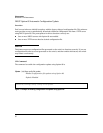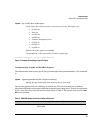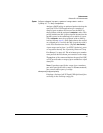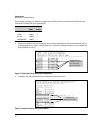
42
Enhancements
Release R.11.17 Enhancements
TCP/UDP Port Number Ranges. There are three ranges:
■ Well-Known Ports: 0 - 1023
■ Registered Ports: 1024 - 49151
■ Dynamic and/or Private Ports: 49152 - 65535
For more information, including a listing of UDP/TCP port numbers, go to the Internet Assigned
Numbers Authority (IANA) website at:
www.iana.org
Then click on:
Protocol Number Assignment Services
P (Under “Directory of General Assigned Numbers” heading)
Port Numbers
Assigning an 802.1p Priority Based on TCP or UDP Port Number or Range of Port
Numbers
This option assigns an 802.1p priority to (IPv4) TCP or UDP packets as described below.
Syntax: [no] qos < udp-port | tcp-port > <portnum | <range <start > <end>>>
< priority < 0 - 7 > | dscp <codepoint>>
Configures the outbound 802.1p priority for incoming
packets having the specified TCP or UDP application
port number or range of port numbers. This priority
determines the packet’s queue in the outbound port to
which it is sent. If the packet leaves the switch on a
tagged port, it carries the 802.1p priority with it to the
next downstream device.
A port range can be from 1 to 65535 (inclusive) ports
or any subset thereof. See “Operating Notes on Using
Port Ranges” below. The minimum port number must
precede the maximum port number in the range.
(Default: Disabled)
The no form of the command deletes the specified UDP
or TCP port number or range of port numbers as a QoS
classifier.
Note: If you have specified a range of port numbers,
you must specify the entire range in the no command;
you cannot remove part of a range.
show qos tcp-udp-port-priority


















